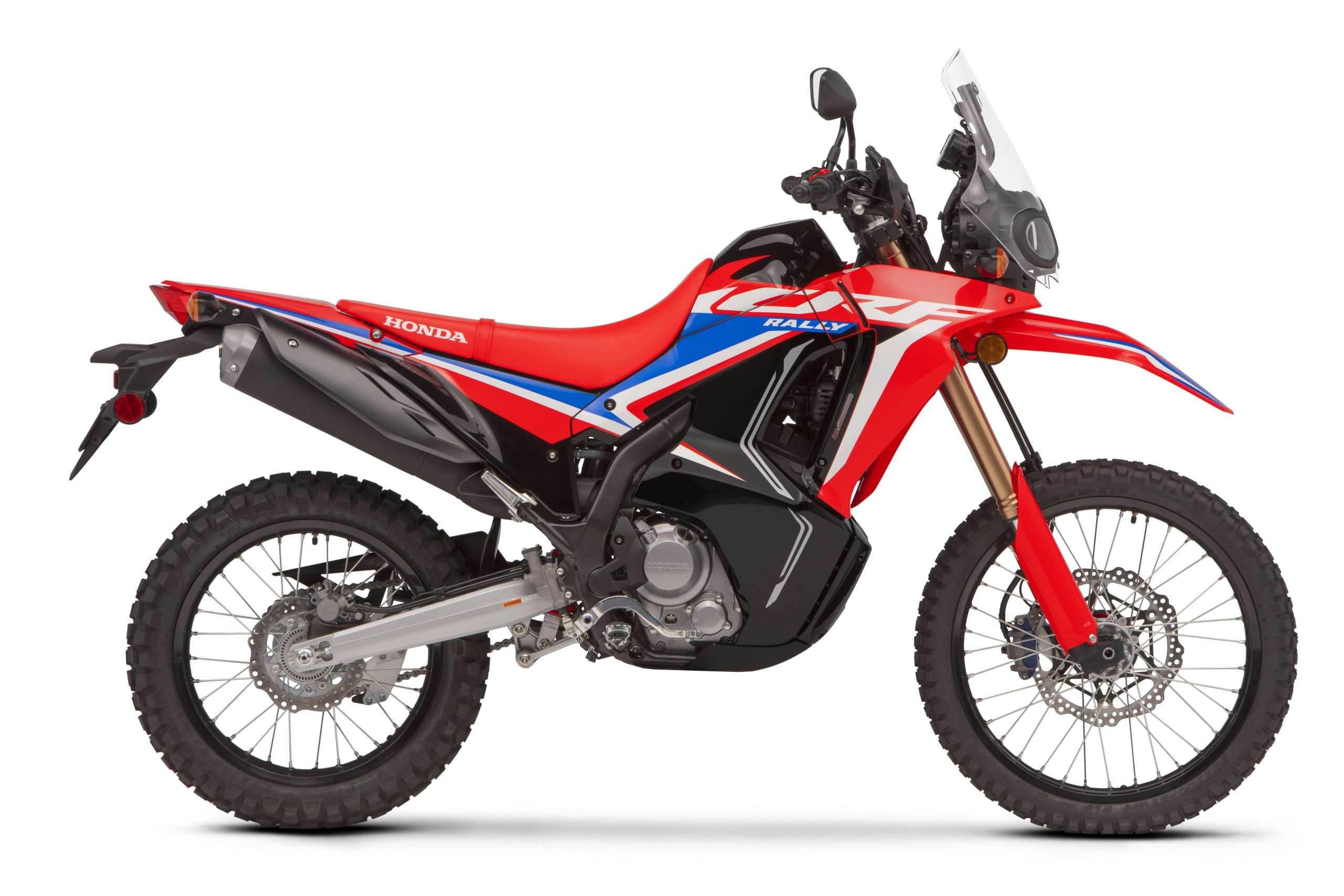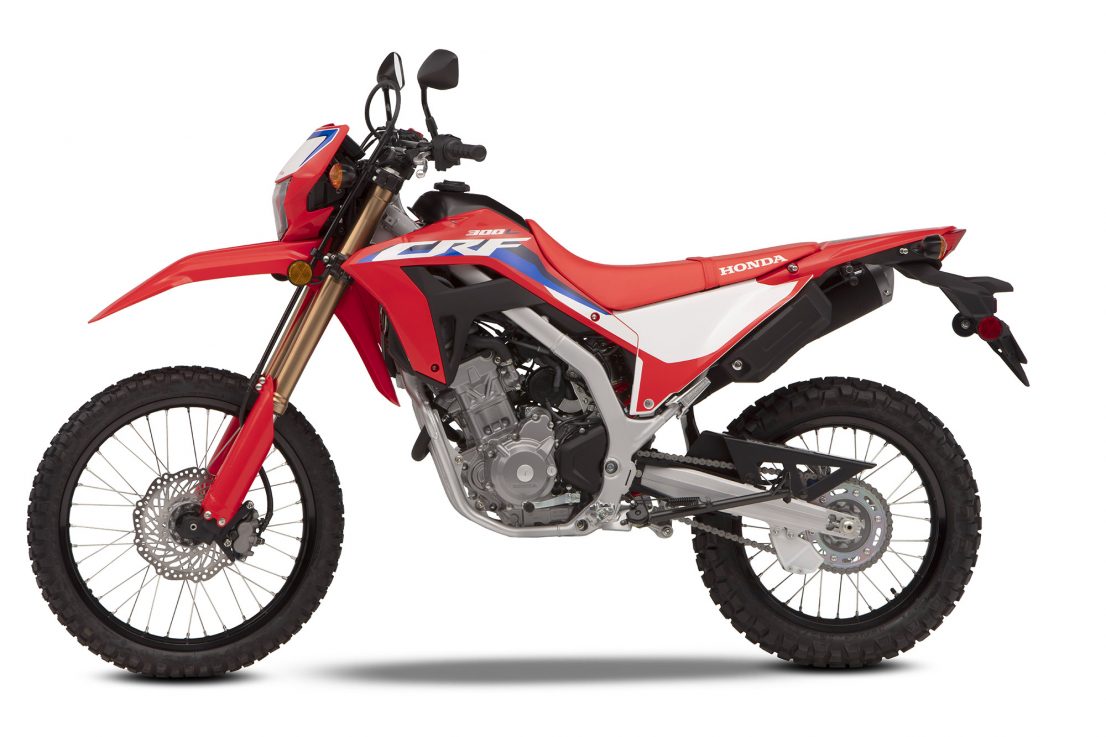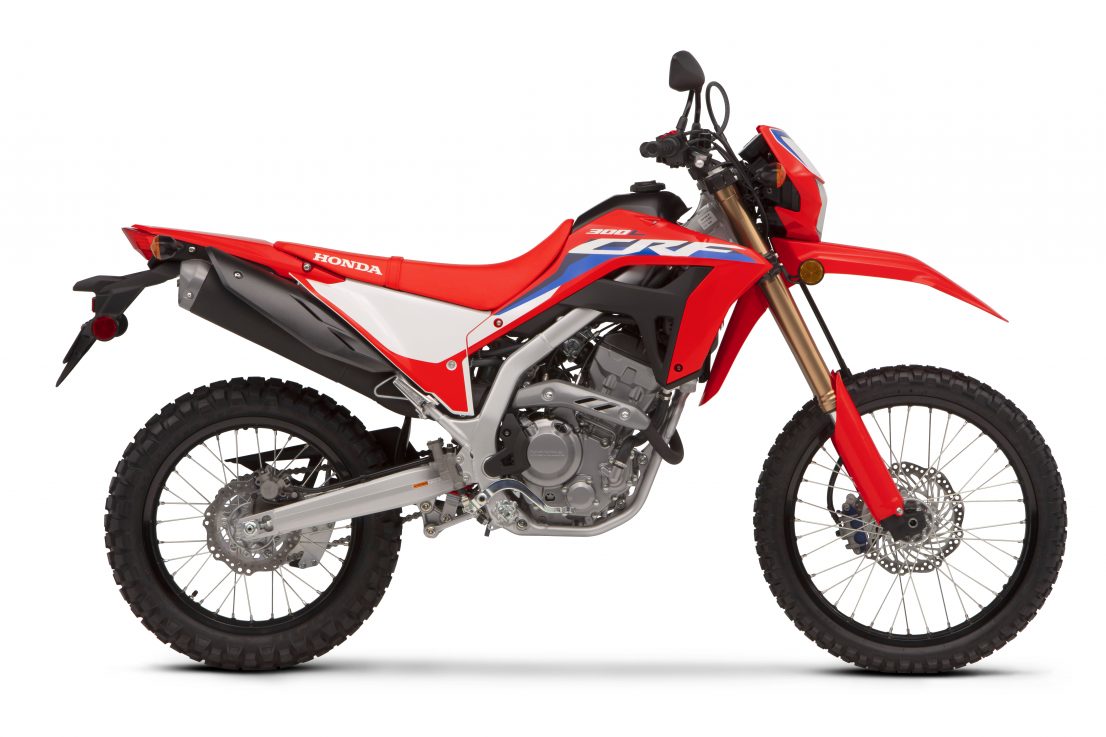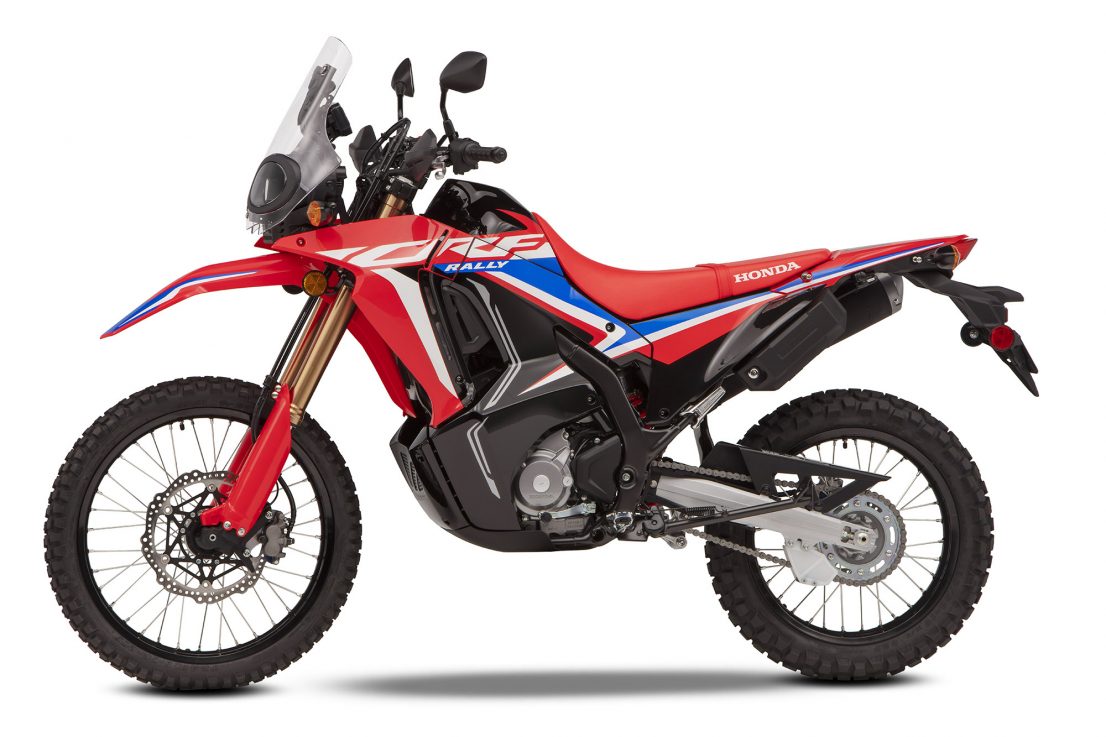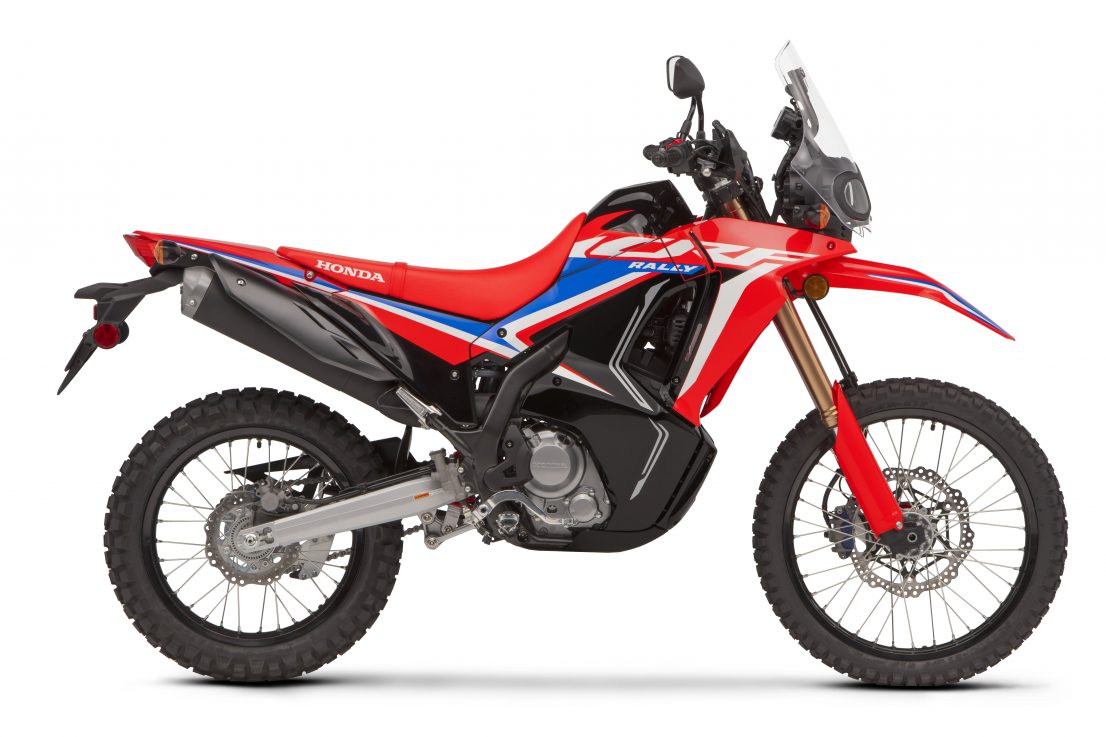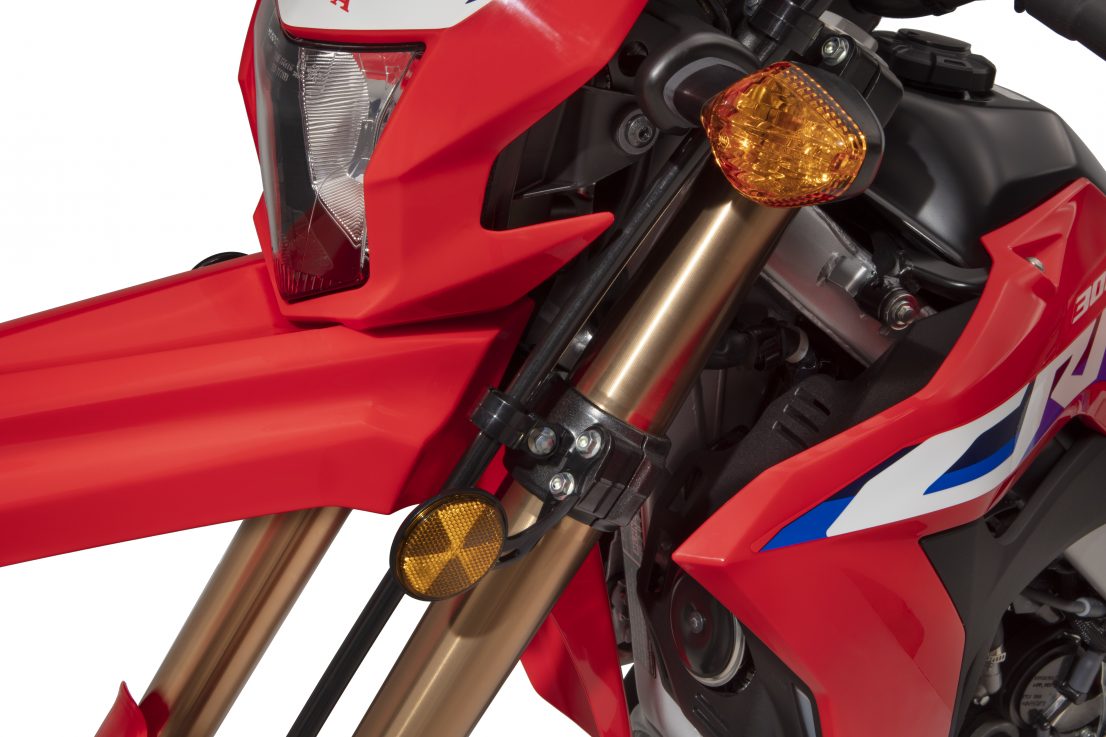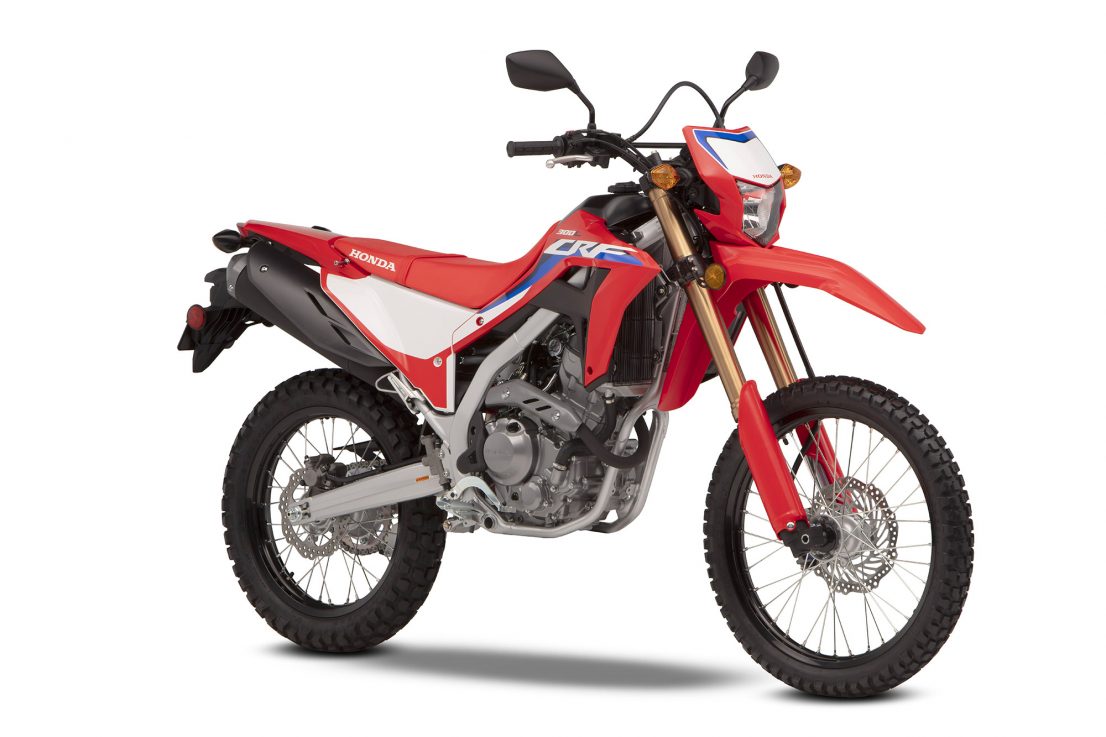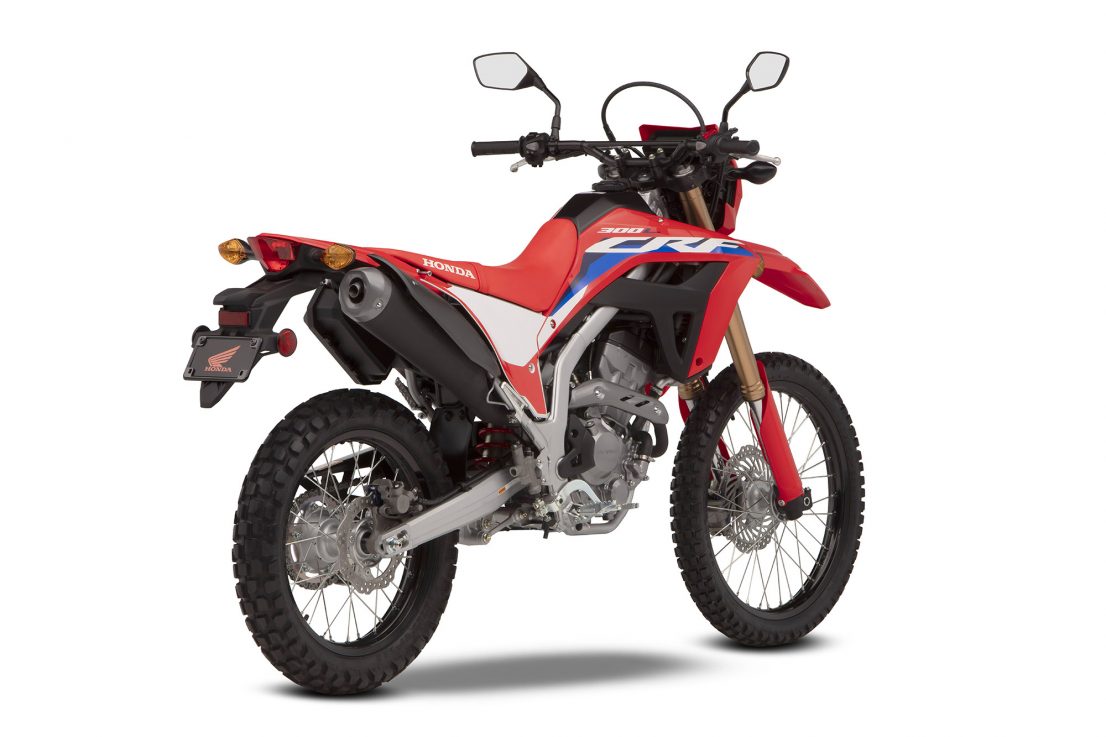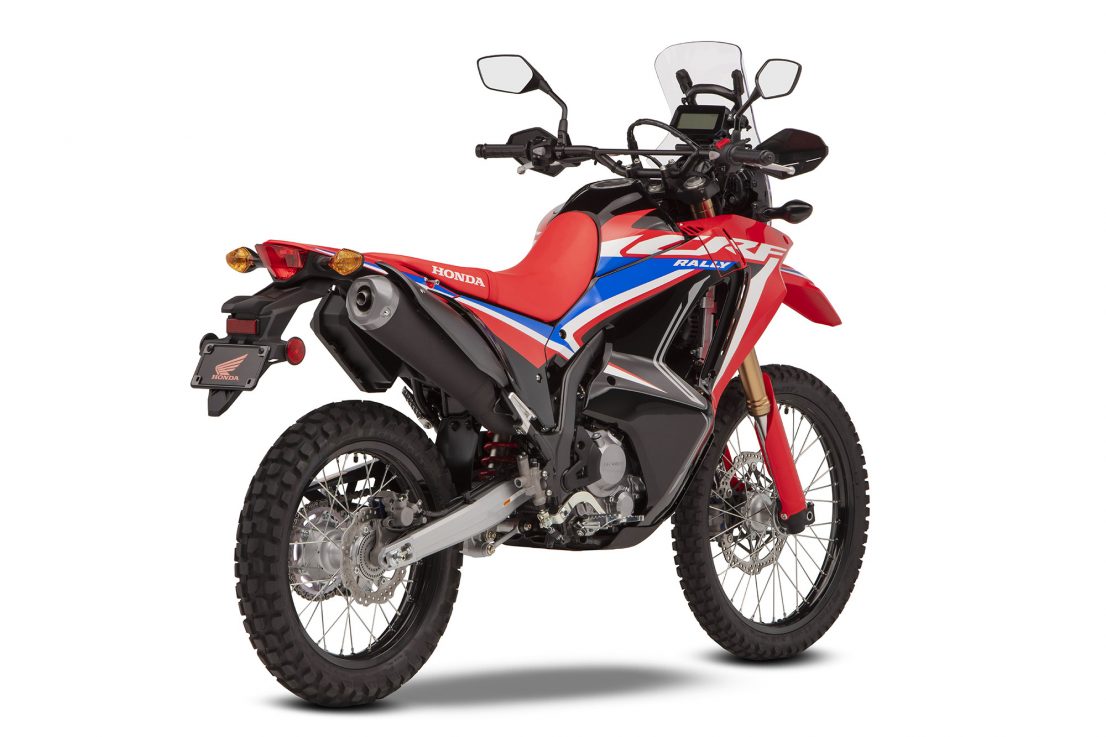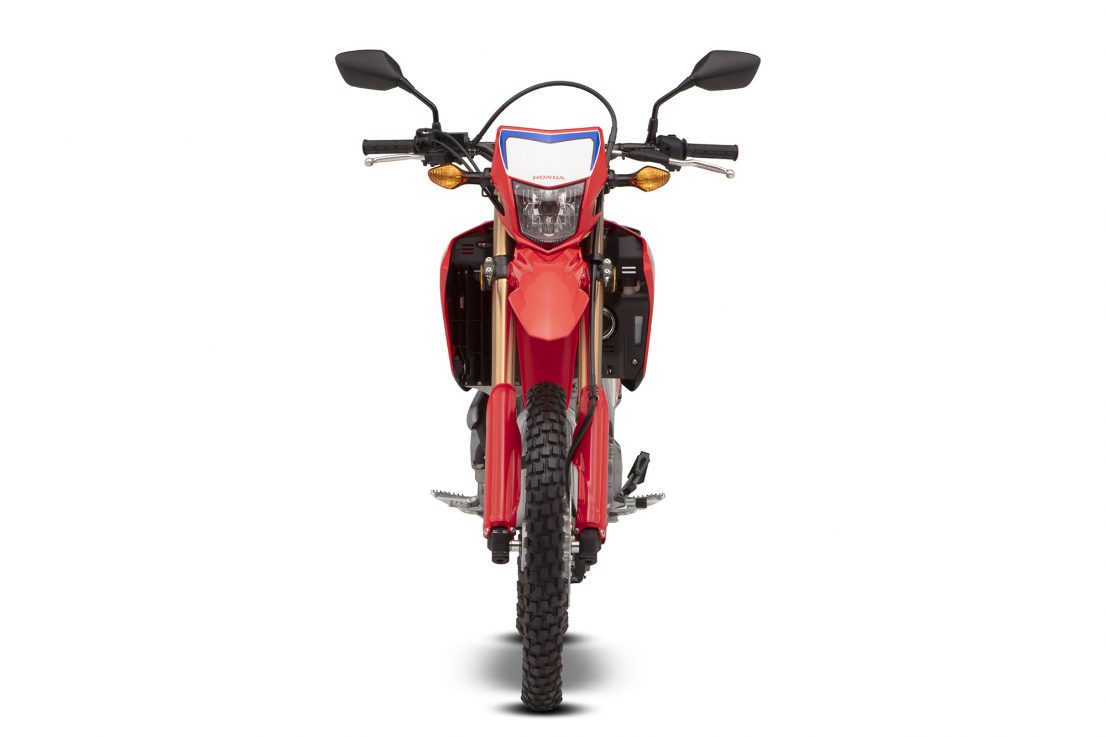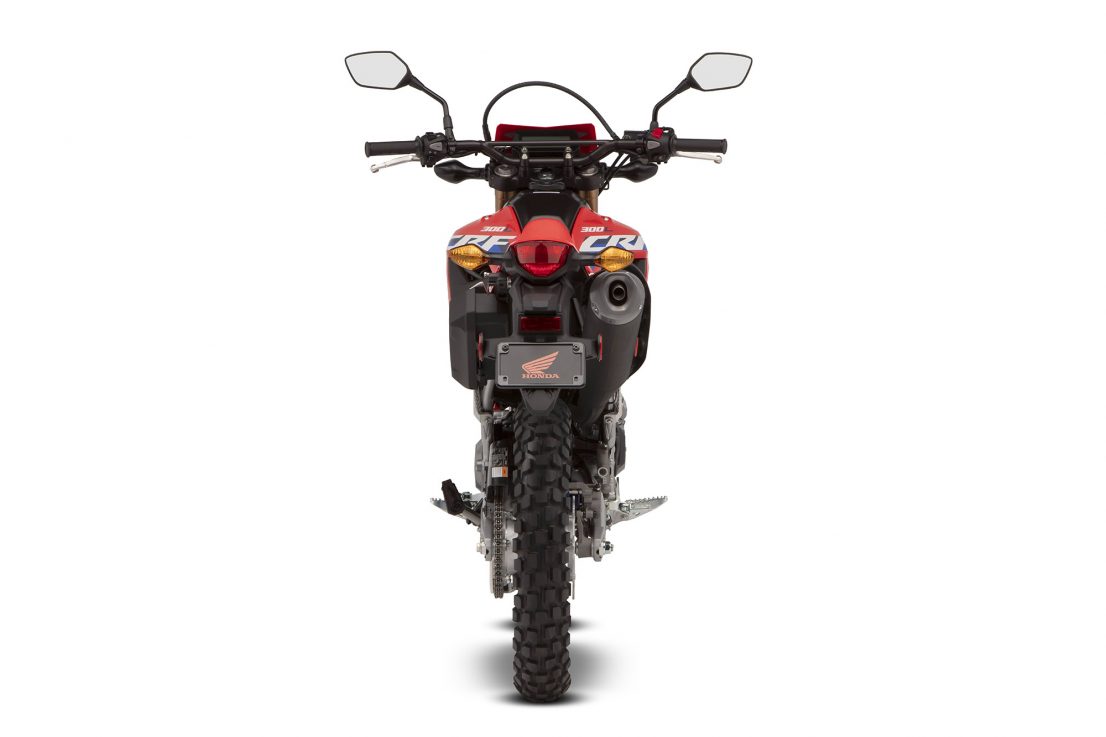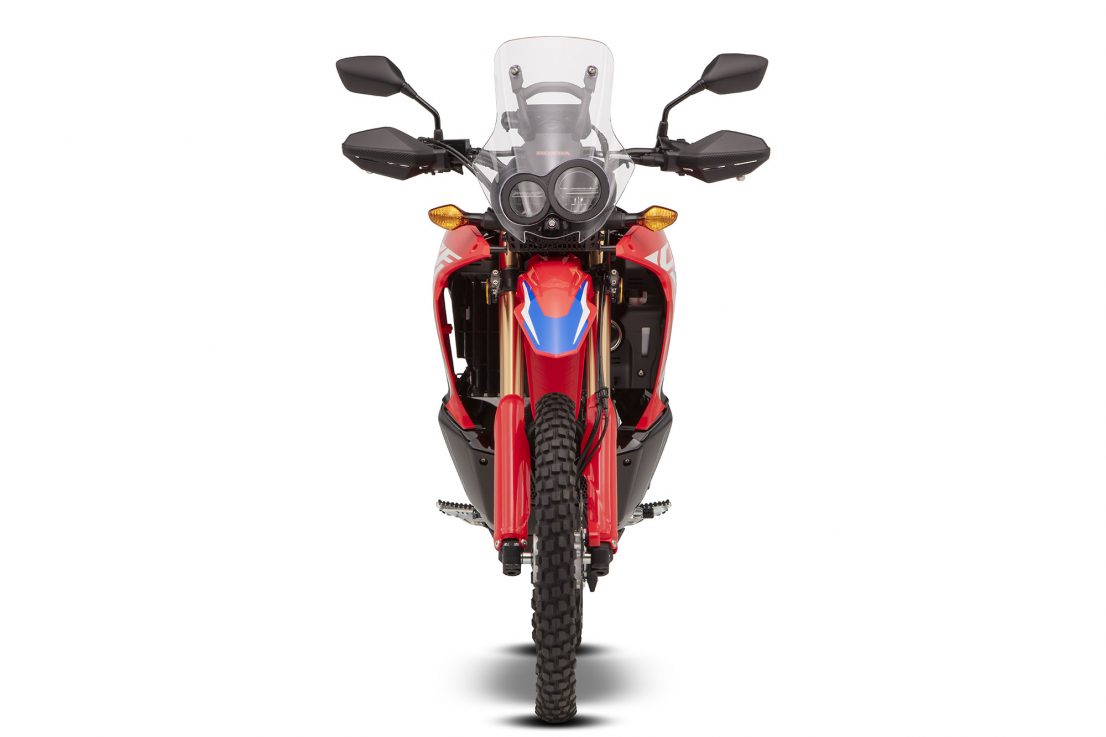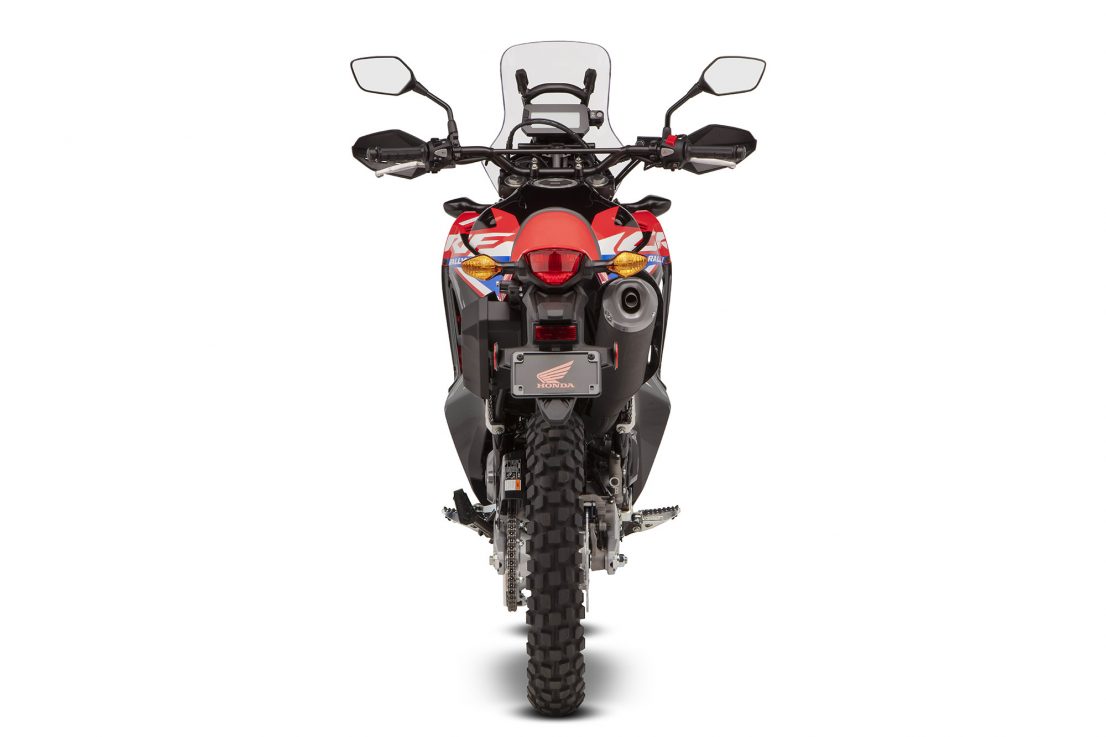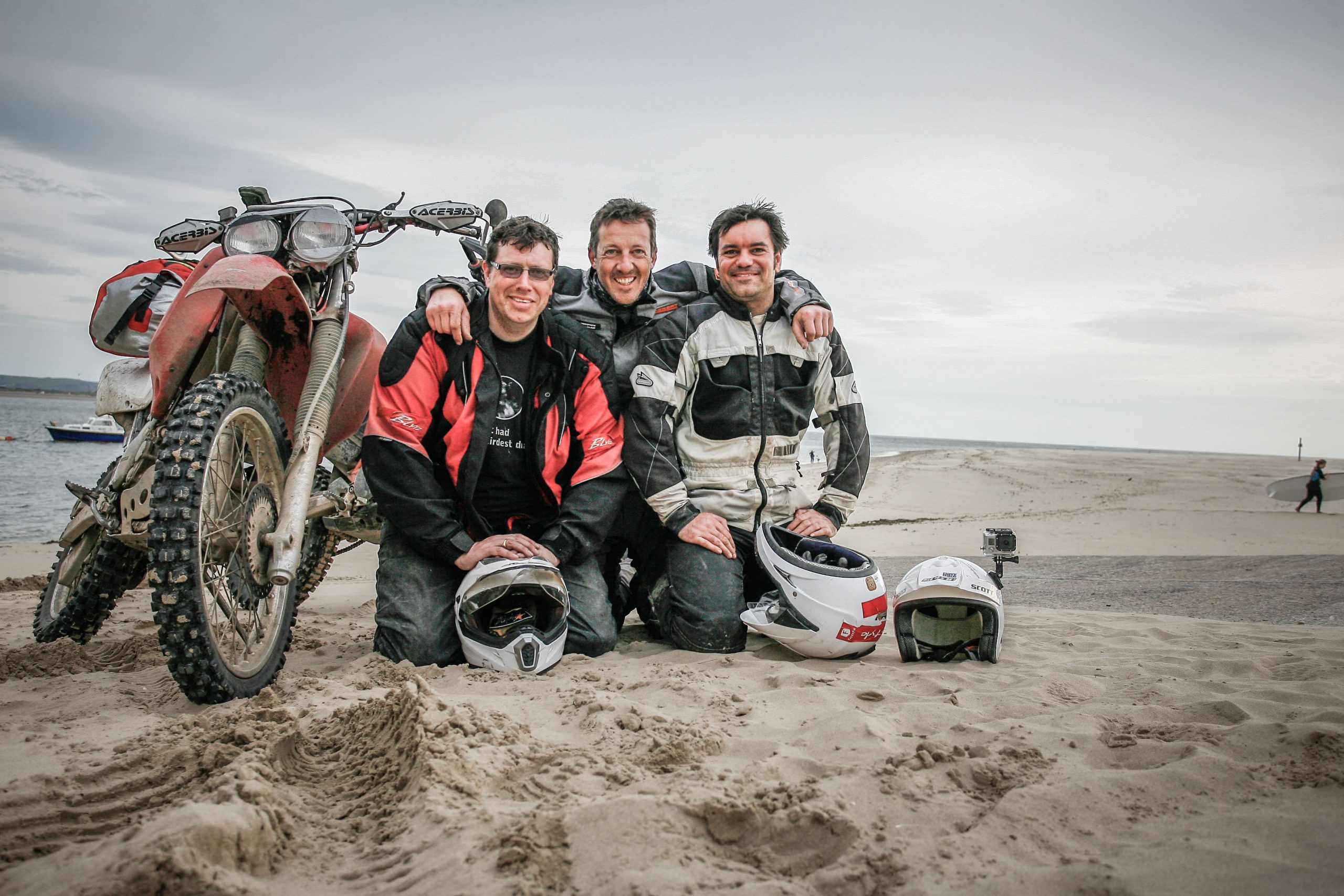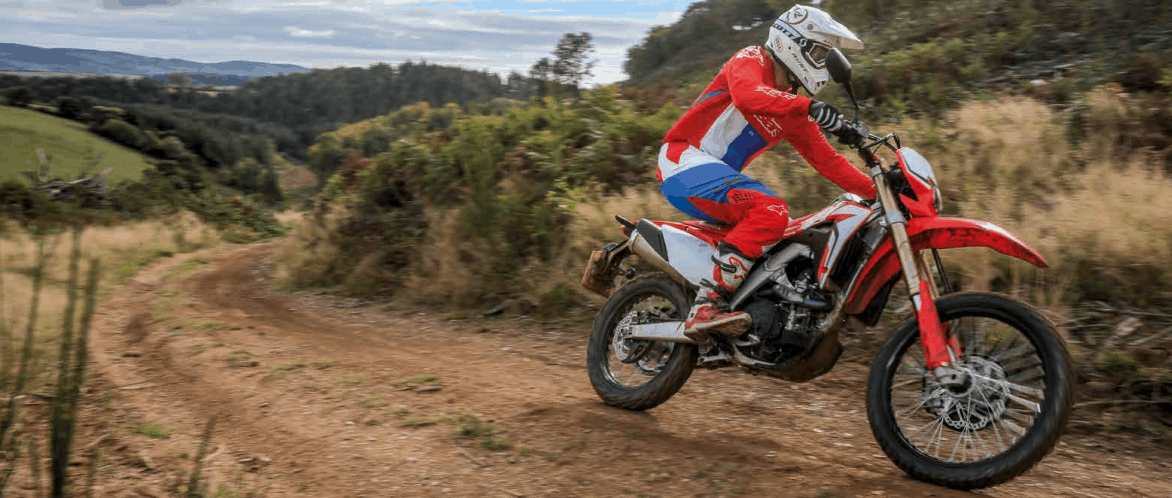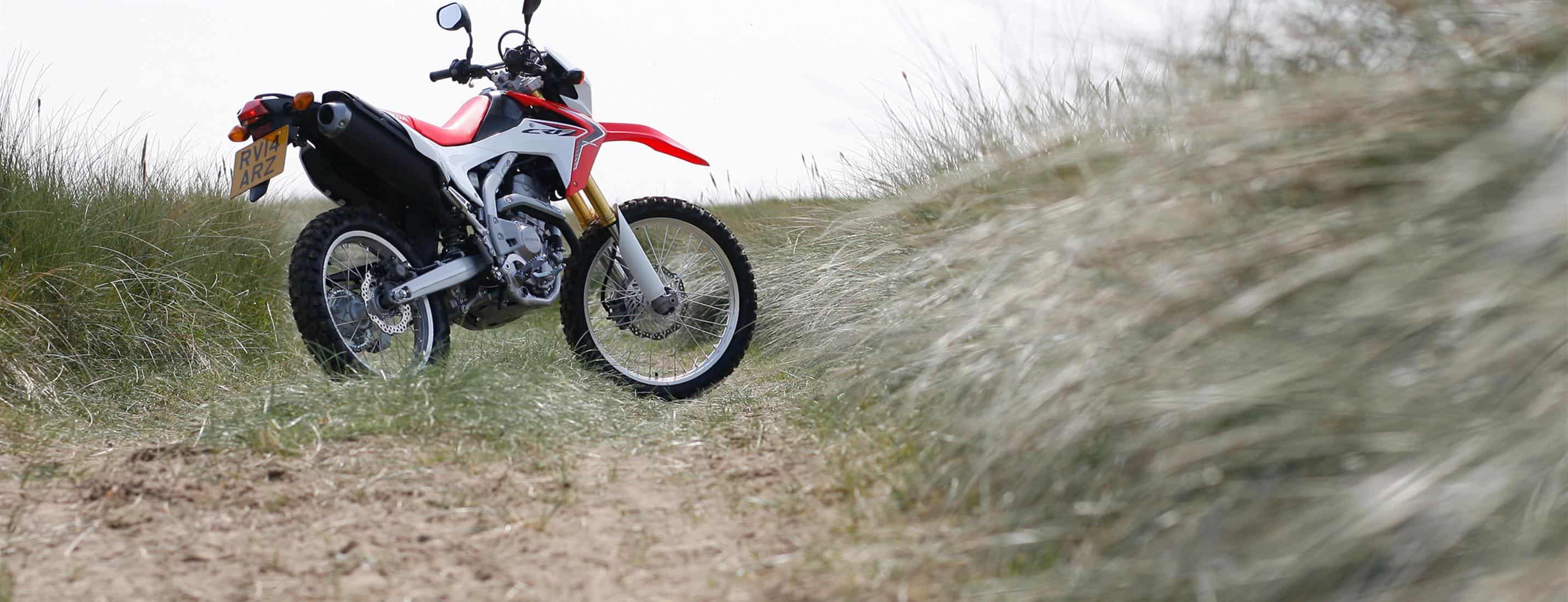Honda CRF300 L
Honda is updating its long-running CRF250L (first seen in 2012). A super-popular trail bike from the beginning, thanks to its budget pricing, go-anywhere capability not to mention excellent reliability and durability – well, now we’re getting more of the same as the capacity jumps from 250 to 286cc. Other dimensions and measurements are upsizing too, although the essence of the bike remains the same. What we love – made better.
THE KEY CHANGES: CRF300L
2020 CRF250L | 2021 CRF300L | |
Price | £4959 | £4999 |
Bore x stroke | 76 x 55mm | 76 x 63mm |
Capacity | 249.6cc | 286cc |
Power | 18.2kW | 20.1kW |
Torque | 22.6Nm | 26.6Nm |
Suspension stroke | 250/240mm | 260/260mm |
Ground clearance | 255mm | 285mm |
Seat height | 875mm | 880mm |
Fuel capacity | 7.8 litres | 7.8 litres |
Kerb weight | 146kg | 142kg |
Top speed | 129km/h | 135km/h |
SO WHAT’S THE NEWS WITH THE CRF300L?
10% MORE POWER – having stroked the engine from 55 to 63mm
17% MORE TORQUE – very handy
TALLER 6TH GEAR – 1st to 5th gears are shorter, but 6th gear is longer adding 6km/h top speed (and easier cruising)
ASSIST/SLIPPER CLUTCH – like so many bikes now
NEW FRAME – it’s lighter but also (surprisingly) engineered to be more flexy!
LESS WEIGHT – down by 4kg
SUBSTANTIALLY RAISED GROUND CLEARANCE – up from 255 to 285mm is a big boon (real rut clearing stuff) without a a massive compromise on seat height
NEW LCD instrument display – should be easier to read
ONE PIECE FRAME – Honda has already taken a bit of flack for this, as a detachable subframe (as on the old CRF) is seen as a better bet for crash damage repairs. The bolt-on subframe has gone, the subframe now welded directly to the main frame
NEW HEADLAMP (NOT) – Hey, what happened there, we’ve seen pictures of the new 300L with an LED headlight like the 450L. Seems not for us
HONDA CRF300 RALLY
The Rally model came five years after the L – in 2017 – but its been a popular variation due to its extra fuel range and longer suspension. And the cool styling. The CRF 300 RALLY looks like its building on that blend, bringing even more range with a bigger tank and seemingly a plusher seat, not to mention rubber inserts and other vibration-isolating measures. The L is the trail bike, this is even more now the long-distance option, as the same implies.
THE KEY CHANGES: CRF300 RALLY
2020 CRF250 RALLY | 2021 CRF300 RALLY | |
Price | £5649 | £6100 estimated |
Bore x stroke | 76 x 55mm | 76 x 63mm |
Capacity | 249.6cc | 286cc |
Power | 18.2kW | 20.1kW |
Torque | 22.6Nm | 26.6Nm |
Suspension stroke | 250/260mm | 260/260mm |
Ground clearance | 270mm | 275mm |
Seat height | 895mm | 885mm |
Fuel capacity | 10.1 litres | 12.8 litres |
Kerb weight | 157kg | 153kg |
Top speed | 129km/h | 135km/h |
SO WHAT’S THE NEWS WITH THE CRF300 RALLY?
SAME AS THE CRF300L, PLUS…
MORE FUEL – The fuel tank is bigger by 2.7 litres which according to Honda will give a 410km range!
LOWER SEAT – fair go! Broader too, and rubber mounted, so it should be more comfortable
LED HEADLIGHT & INDICATORS – but a bulb tail light. Go figure!
SOME DETAIL
Taken direct from the horse’s mouth (Honda):
ENGINE updates:
An extra 14% cubic capacity for the single-cylinder, liquid-cooled DOHC engine – from 250cc to 286cc – is acquired by a 63mm stroke, as opposed to 55mm. Bore remains unchanged at 76mm, as does compression ratio of 10.7:1. Peak power of 20.1kW arrives @ 8,500rpm, peak torque of 26.6Nm @ 6,500rpm (up from 18.2kW @ 8.500rpm/22.6Nm @ 6,750rpm). The full dyno graph curves tells the full story beyond the peak power and torque uplift: the new engine is considerably stronger, everywhere, from 2,000rpm up.
To match the engine’s heavier punch and again, to smarten pick-up and acceleration, gear ratios 1-5 are shorter while 6th gear is taller, for more relaxed highway cruising. Addition of an assist/slipper clutch reduces lever load by 20% and manages rear wheel ‘hop’ on rapid downshifts – great for control, on or off-road. On the highway, top speed goes from 129km/h to 135km/h.
Revised timing of the intake cam specifically boosts low- to mid-range response – the rpm range most used around town or off-road – and works with a redesigned air filter, exhaust downpipe , muffler and ignition timing. An iridium spark plug, along with precise metering of fuel from the PGM-FI injection system, further enhances combustion efficiency and improves environmental credentials.
The engine uses an offset cylinder, reducing internal frictional losses, while the piston itself incorporates a special surface material, plus molybdenum coating. The oil pump features an internal relief structure that prevents aeration of relieved oil. The crank journal employs a half-split, press-fit metal bearing while the crank bearing uses a cast-iron bush. A primary balance shaft further reduces vibration.
The cooling system uses a 12.7kW heat-release radiator, sited on the left of the bike, protected with a polypropylene grill baffled to improve airflow. A thin guide-ring cooling fan is used to maintain even temperatures at low speeds, either in congested traffic or tricky off-road situations.
The engine is fully EURO5 compliant.
CHASSIS updates – CRF300L
A total of 4kg has been saved overall from the CRF300L’s chassis, with wet weight of 142kg. The steel semi-double cradle frame is completely new and contributes 2.15kg to the weight loss. Just as importantly, to promote handling feel and connection to front/rear traction, its flexibility balance has been tuned with 25% less lateral rigidity.
This has been achieved with decreased width of 30mm for the main down tube and smaller, 25.4mm diameter lower down tubes (from 28.6mm) plus a 20mm decrease in width across the central bracing tube.
To match, the one-piece cast aluminium swingarm is not only 550g lighter, it features a 23% reduction in lateral rigidity. It’s also 15mm narrower just behind the pivot point and smooth, cross-sectional shaping is used to create uniform deflection. Extruded aluminium is used for the chain adjustment collar. The steel bottom yoke of the previous design has been changed for aluminium; this shaves 730g from an area high relative to the centre of gravity for faster steering response.
The 43mm Showa inverted fork gains 10mm of stroke to 260mm, with spring weight and damping settings revised for precise control over a wide range of terrain and speeds. Pro-Link rear suspension now features a 260mm axle stroke, from 240mm; the Showa shock absorber is a single tube design.
Ground clearance has been increased, from 255 to 285mm and the frame and engine sit 20mm higher, thanks to revisions to the lower frame, engine crankcases and oil drain plug. Rake and trail are now set at 27.5°/109mm (from 27.6°/113mm) with 10mm longer wheelbase of 1455mm. Turning radius is 2.3m.
The front brake uses a single 256mm disc gripped by a two-piston caliper, the rear a 220mm disc and single-piston caliper; in common with the CRF competition machines the rear master cylinder is now a lightweight, integrated design. The discs feature a wave design – also taken directly from the CRF250R/CRF450R – with exceptional self-cleaning abilities in adverse conditions. 2-channel ABS is standard.
Lightweight aluminium rims further reduce unsprung mass; for 2021 the Alumite surface has been polished to gloss finish. Block pattern enduro-style tyres (front, 80/100-21 51P and rear 120/80-18 62P) provide traction in a wide range of riding situations.
The 21-inch front wheel and 18-inch rear increase stability on rough terrain and allow the fitment of more off-road specific tyres if required. Application of a machined rear sprocket and M8 bolts (instead of M10) plus hollow rear axle saves 240g and 160g respectively.
CHASSIS updates – CRF300 RALLY
A total of 4kg has been saved overall from the CRF300 RALLY’s chassis, with wet weight now of 153kg. The steel semi-double cradle frame is completely new and contributes 2.15kg to the weight loss. Just as importantly, to promote handling feel and connection to front/rear traction, its flexibility balance has been tuned with 25% less lateral rigidity.
This has been achieved with decreased width of 30mm for the main down tube and smaller, 25.4mm diameter lower down tubes (from 28.6mm) plus a 20mm decrease in width across the central bracing tube.
To match, the one-piece cast aluminium swingarm is not only 550g lighter, it features a 23% reduction in lateral rigidity. It’s also 15mm narrower just behind the pivot point and smooth, cross-sectional shaping is used to create uniform deflection. Extruded aluminium is used for the chain adjustment collar. The steel bottom yoke of the previous design has been changed for aluminium; this shaves 730g from an area high relative to the centre of gravity for faster steering response.
The 43mm Showa inverted fork gains 10mm of stroke to 260mm, with spring weight and damping settings revised for precise control over a wide range of terrain and speeds. Pro-Link rear suspension features a 260mm axle stroke; the Showa shock absorber is a single tube design .
Ground clearance has been increased, from 270mm to 275mm thanks to revisions to the lower frame, engine crankcases and oil drain plug. Rake and trail are now set at 27.5°/109mm (from 27.6°/113mm) with 10mm longer wheelbase of 1455mm.
The front brake uses a single 296mm disc gripped by a two-piston caliper, the rear a 220mm disc and single-piston caliper; in common with the CRF competition machines the rear master cylinder is now a lightweight, integrated design. The discs feature a wave design – also taken directly from the CRF250R/CRF450R – with exceptional self-cleaning abilities in adverse conditions. 2-channel ABS is standard.
Lightweight aluminium rims further reduce unsprung mass; for 2021 the Alumite surface has been polished to a gloss finish. Block pattern enduro-style tyres (front, 80/100-21 51P and rear 120/80-18 62P) provide traction in a wide range of riding situations.
The 21-inch front wheel and 18-inch rear increase stability on rough terrain and allow the fitment of more off-road specific tyres if required. Application of a machined rear sprocket and M8 bolts (instead of M10) plus hollow rear axle saves 240g and 160g respectively.
Now to precis their last bit…
STYLING updates – CRF300L
The L gets new bodywork that’s lighter and slimmer, with associated refreshed graphics. The fuel tank might be the same size as before but its made slimmer and 190g lighter. The riding position has changed, with bars more rear-set as are the footpegs, which have also been lowered, along with a higher seat height it’s possibly more ‘roomy’. Both the front mudguard and rear taillight assembly are said to be lighter, too. The sidestand gets a slightly larger foot. The instrument panel now features a white display background and larger digits!
STYLING updates – CRF300 RALLY
Like the L, the Rally gets lighter, slimmer bodywork, despite the bigger fuel tank. The seat is now rubber mounted and now 20mm wider in the seating area, while the same slim design at the front.
As with the L, there are the new dimension with the handlebars set back, pegs set back and lowered. To eliminated unwanted vibrations – showing the long distance emphasis here – there are rubber inserts in the foot pegs and internal handlebar weights.
Other detail changes as per the L model.
A GOOD REFRESH
In all, and with the capacity increase notionally moving these into the ‘300s’ category, do these changes move the two CRFs closer to KTM 390 Adventure and BMW 310 GS territory? Not entirely as these are still much more trail bike than those two adventurers. The CRFs are dirt bikes first, whereas the KTM and BMW start as road bikes, a point of difference that serves Honda well.
Equally at about 26hp these are not as powerful as the KTM and BMW, by some measure. But given Honda’s venerable enduro bike the CRF250X (2004-2018) only made 28.5hp you can see the new 300s are getting nicely peppy. Certainly there will be plenty of existing owners and potential new CRF owners for whom these changes look very attractive indeed. That ground clearance improvement on the L – for British green lanes – is significant in itself. Altogether this looks like a very nice job by Honda, with both models giving us more of what we like without spoiling the essence of the originals. Don’t fix what ain’t broke and all that!

